
Orchids are plants that belong to the family Orchidaceae, a diverse and widespread group of flowering plants with blooms that are often colourful and fragrant. Orchids are cosmopolitan plants that are found in almost every habitat on Earth except glaciers. The world's richest diversity of orchid genera and species is found in the tropics.
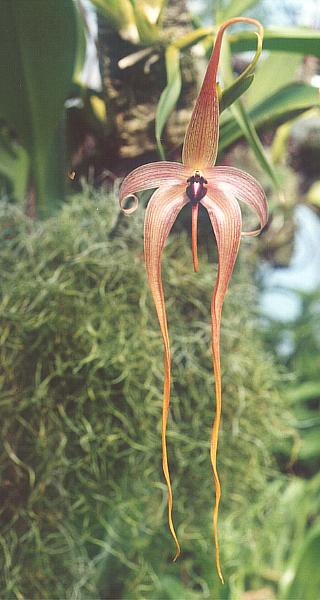
Bulbophyllum is a genus of mostly epiphytic and lithophytic orchids in the family Orchidaceae. It is the largest genus in the orchid family and one of the largest genera of flowering plants with more than 2,000 species, exceeded in number only by Astragalus. These orchids are found in diverse habitats throughout most of the warmer parts of the world including Africa, southern Asia, Latin America, the West Indies, and various islands in the Indian and Pacific Oceans. Orchids in this genus have thread-like or fibrous roots that creep over the surface of trees or rocks or hang from branches. The stem is divided into a rhizome and a pseudobulb, a feature that distinguished this genus from Dendrobium. There is usually only a single leaf at the top of the pseudobulb and from one to many flowers are arranged along an unbranched flowering stem that arises from the base of the pseudobulb. Several attempts have been made to separate Bulbophyllum into smaller genera, but most have not been accepted by the World Checklist of Selected Plant Families.

Heinrich Gustav Reichenbach was a botanist and the foremost German orchidologist of the 19th century. His father Heinrich Gottlieb Ludwig Reichenbach was also a well-known botanist.
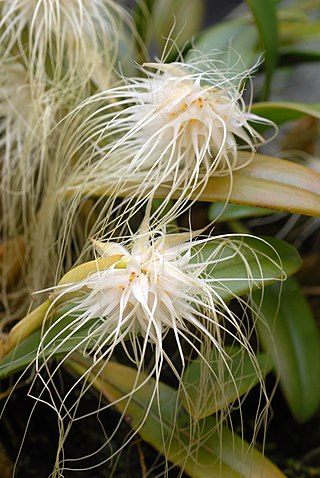
Bulbophyllum medusae, commonly known as the Medusa orchid, is a species of epiphytic orchid with a creeping rhizome and a single leaf about 100 mm (3.9 in) long emerging from the top of each pseudobulb. The flowers are creamy yellow and arranged in clusters of about fifteen arranged in a circle at the tip of the flowering stem. The flowers have an unpleasant odour. The flowers have thread-like lateral sepals about 120 mm (4.7 in) long, giving each cluster the appearance of Medusa.
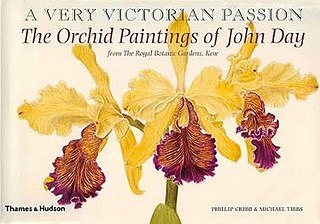
John Day (1824–1888) was an English orchid-grower and collector, and is noted for producing some 4000 illustrations of orchid species in 53 scrapbooks over a period of 15 years. These scrapbooks were donated to The Royal Botanic Gardens, Kew in 1902 by his sister, Emma Wolstenholme.The standard author abbreviation J.Day is used to indicate this person as the author when citing a botanical name.

Dendrobium parishii is a species of orchid native to Asia.

Bulbophyllum apodum is a species of orchid in the genus Bulbophyllum. It bears a 12–14 cm inflorescence with around 40 small fragrant white flowers on it. It is native to Sikkim, Borneo, China, Malaysia, Thailand, the Philippines, Vanuatu, and Vietnam.
Bulbophyllum argyropus, commonly known as the silver strand orchid, is a species of epiphytic or sometimes lithophytic orchid that is endemic to eastern Australia, including Lord Howe and Norfolk Islands. It has crowded pseudobulbs, tough, dark green leaves and up to four small whitish to yellowish flowers with an orange labellum.

Bulbophyllum muscicola is a species of orchid in the genus Bulbophyllum. It is native to the eastern Himalayan region, and the Asian tropics.

Bulbophyllum ovalifolium is a species of orchid in the genus Bulbophyllum.
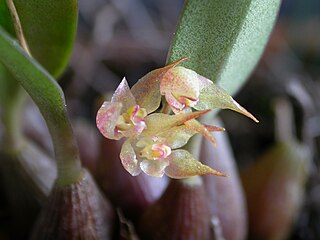
Bulbophyllum scabratum or Rough Bulb-Leaf Orchid is a species of orchid in the genus Bulbophyllum in section Eublepharon.
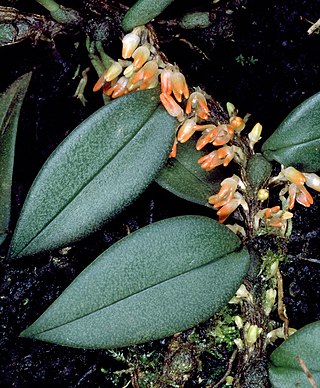
Bulbophyllum schillerianum, commonly known as the red rope orchid, is a species of epiphytic or lithophytic orchid. It has well-spaced pseudobulbs each with a single grooved leaf and cluster of small, red or orange flowers with a hairy labellum. It grows on trees and rocks sometimes in rainforest but also on trees in cleared paddocks, and is endemic to eastern Australia.
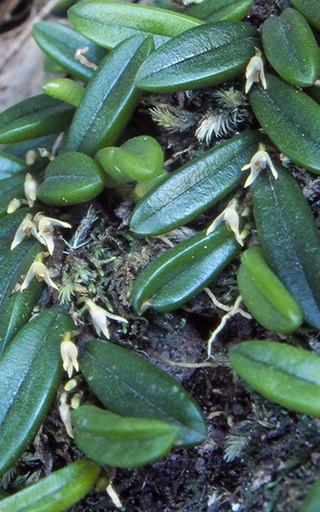
Bulbophyllum shepherdii, commonly known as the wheat-leaf rope orchid, is a species of epiphytic or lithophytic orchid that forms a dense mat of branching rhizomes pressed against the surface on which it grows. The pseudobulbs are well spaced along the rhizome, each with a single egg-shaped leaf and a single small, white or cream-coloured flower with yellow tips. It grows on trees and rocks in rainforest and is endemic to eastern Australia.
Bulbophyllum unguiculatum is a species of orchid in the genus Bulbophyllum. It is commonly known as the clawed bulbophyllum. It is found in Sumatra, Java, Borneo and Sulawesi in lower montane forests.

Bulbophyllum trigonopus is a species of epiphytic orchid that is found in Borneo and from Thailand to Malaysia. It was first formally described in 1881 by Heinrich Gustav Reichenbach who gave it the name Cirrhopetalum trigonopus and gave Bulbophyllum trigonopus as a synonym. The description was published in The Gardeners' Chronicle along with the first formal description of Cirrhopetalum abbreviatum. In 2017 Poh Teck Ong changed the name to Bulbophyllum trigonopus and the change has been accepted by the World Checklist of Selected Plant Families with Cirrhopetalum abbreviatum now regarded as a synonym of Bulbophyllum trigonopus.

Chytroglossa is a genus of flowering plants from the orchid family, Orchidaceae. It contains three recognized species, all endemic to southeastern Brazil.
Bulbophyllum nocturnum is a species of epiphytic orchid that grows in New Britain. It was described in 2011, and is the first species of orchid known to consistently flower during the night, and close its flowers during the day.

Dendrobieae is a tribe in the subfamily Epidendroideae, in the family Orchidaceae. The Dendrobieae are mostly tropical, epiphytic orchids which contain pseudobulbs.

Bulbophyllum maxillare, commonly known as the red horntail orchid, is a species of epiphytic orchid with tapered grooved, dark green to yellowish pseudobulbs, each with a single large, thin leaf and a single reddish flower with yellow or white edges. The lateral sepals are much larger than the dorsal sepal which in turn is much larger than the petals. It grows on the lower branches of rainforest trees in India, New Guinea and tropical North Queensland.

Charles Samuel Pollock Parish (1822–1897) was an Anglo-Indian clergyman and botanist who served as chaplain to the forces of the Honourable East India Company in Burma. With his wife Eleanor he collected and painted plants, chiefly orchids, identifying and naming a number of species new to science. Several species are named in his honour.

















